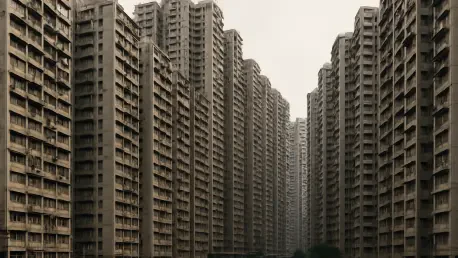In an era where urban populations continue to soar, the demand for innovative housing solutions has given rise to architectural marvels that defy conventional design, reshaping cityscapes worldwide. Across the globe, residential megastructures are redefining how people live, blending staggering scale with functionality and luxury to address the challenges of city living. Two such extraordinary buildings stand out for their sheer ambition and unique approaches to urban density. One is a colossal apartment complex in China, known for housing thousands in a self-contained ecosystem, while the other is a towering icon in New York City, representing the pinnacle of height and exclusivity. These structures not only push the boundaries of engineering but also offer a fascinating glimpse into the diverse ways modern societies tackle the pressures of urbanization. Their stories reveal how architecture can shape lifestyles, cater to different demographics, and reflect cultural priorities in an increasingly crowded world.
Exploring Unprecedented Scale in Urban Living
A Micro-City Within Walls
In Qianjiang Century City, China, a residential complex originally conceived as a luxury hotel has transformed into a staggering example of high-density living. Standing at 675 feet with 39 floors, this megastructure spans 1.47 million square meters and currently shelters over 20,000 residents, with the capacity to house up to 30,000. Designed as a self-sufficient hub, it integrates a vast array of amenities directly within its boundaries, from shopping centers and restaurants to hospitals, schools, and fitness facilities. Residents can access everything from grocery stores to salons and even indoor swimming pools without stepping outside, creating a lifestyle of unparalleled convenience. This setup caters to a diverse population, including young professionals seeking affordable urban housing, and has gained significant attention through viral social media content showcasing its immense scale and community dynamics.
Affordable Living in a Massive Complex
The appeal of this Chinese megastructure lies not only in its size but also in its accessibility to a wide range of residents. Rental costs are notably varied, starting at around $209 per month for smaller, windowless units and rising to $558 or more for larger spaces with balconies, making it a viable option for different income levels. Since its opening over a decade ago, the building has become a vibrant hub for a mixed demographic, including influencers drawn to its unique environment. The concept of a micro-city challenges traditional notions of apartment living by minimizing the need for external travel for daily necessities, thus redefining urban convenience. This model raises intriguing questions about the future of residential design in densely populated areas, where space is at a premium, and self-contained ecosystems could become a norm for accommodating growing urban populations with efficiency and practicality.
Heights of Luxury and Engineering Feats
Towering Over Manhattan’s Skyline
On the other side of the world, at 225 West 57th Street in Midtown Manhattan, a residential tower pierces the sky at an awe-inspiring 1,550 feet, claiming the title of the tallest of its kind globally. With 98 above-ground floors, this $3 billion marvel, completed a few years ago, ranks as the second-tallest building in both New York City and the United States, trailing only behind One World Trade Center. It houses 179 luxury condominiums, each averaging 5,000 square feet, catering to an elite clientele seeking exclusivity. Beyond its residences, the tower boasts premium amenities spread across several floors, including a private club on the 100th floor, offering panoramic views and unparalleled prestige. This structure stands as a testament to modern engineering, pushing the limits of height while integrating high-end living spaces into one of the world’s most iconic urban landscapes.
Overcoming Challenges to Reach New Heights
The journey to complete this Manhattan giant was fraught with obstacles that tested the resolve of its developers. Delays arose from concerns over the impact on nearby historic buildings, coupled with financial hurdles and design disputes that complicated the project timeline. Tragically, the construction process was marred by the loss of a security guard, underscoring the risks associated with such ambitious endeavors. Despite these setbacks, construction began over a decade ago, with above-ground work progressing steadily until its eventual completion. The tower’s success highlights the determination to create a landmark that not only redefines New York’s skyline but also sets a benchmark for luxury living. It reflects a broader trend of vertical expansion in major cities, where space constraints drive innovation, though it primarily serves a wealthier demographic, contrasting sharply with other megastructures focused on mass accommodation.
Reflecting on Architectural Extremes
Lessons from Diverse Urban Solutions
Looking back, the stories of these two residential giants reveal how architecture adapts to the pressing demands of urbanization through contrasting visions. One structure in China demonstrates the power of scale and functionality, creating a self-sustaining community for tens of thousands by prioritizing accessibility and convenience over exclusivity. Meanwhile, the Manhattan tower embodies the pursuit of prestige and height, crafting a sanctuary of luxury for a select few despite numerous challenges during its development. Both push the boundaries of engineering in their respective contexts, showcasing how cultural and economic factors shape their purposes. Their legacies offer valuable insights into balancing density with livability, illustrating that there is no one-size-fits-all solution to urban housing challenges.
Future Directions for Megastructure Design
Moving forward, the innovations seen in these buildings suggest a path for future urban planning to address growing populations. Cities might consider hybrid models that blend affordability with high-end features, ensuring inclusivity while maintaining architectural ambition. Planners and developers could explore integrating green spaces and sustainable technologies to enhance the livability of such massive structures. Additionally, learning from past construction challenges, stricter safety protocols and community impact assessments should guide upcoming projects. As urban centers continue to expand, these megastructures serve as blueprints for reimagining residential spaces, encouraging a dialogue on how to create environments that cater to diverse needs while standing as symbols of human ingenuity and resilience in the face of spatial constraints.









